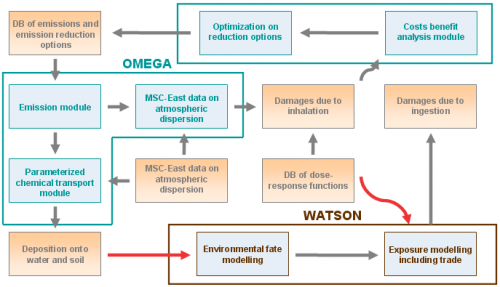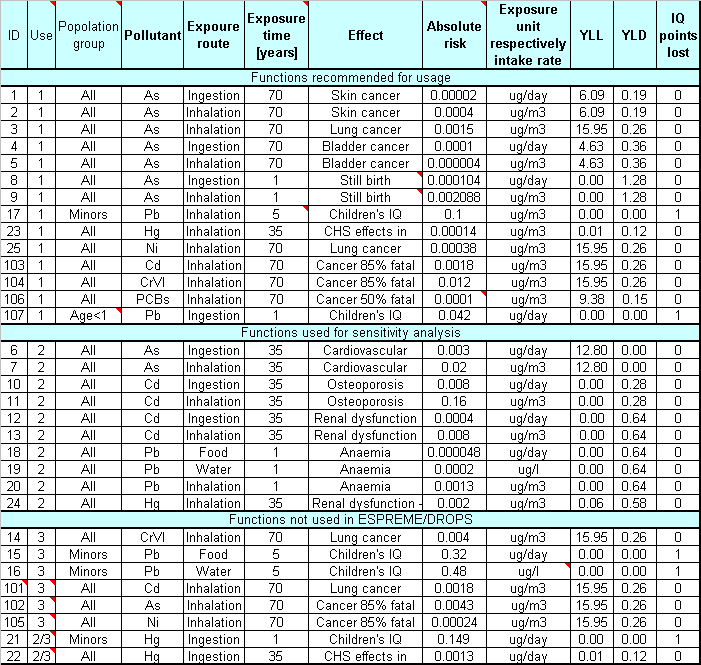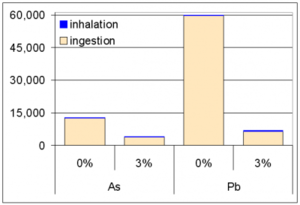Integrated assessment of heavy metal releases in Europe
- The text on this page is taken from an equivalent page of the IEHIAS-project.
The aim of ESPREME was to develop methods and to identify strategies to support EU environmental policy-making for reducing the emissions and thus the harmful impacts of heavy metals (HMs). The core aim of the research was to carry out damage assessment considering heavy metals to the environment and human health in the long term. The priority metals mercury, cadmium, lead, nickel, arsenic and chromium have been covered.
A number of activities of the European Commission and the Convention on Long-range Transboundary Air Pollution of the United Nations Economic Commission for Europe UNECE CLRTAP are focusing on heavy metals (HMs). Revisions of the Air Quality Framework Directive and the Clean Air for Europe program CAFE will benefit from ESPREME results as the development of the EU mercury strategy and further work on the UNECE 1998 Aarhus Protocol on Heavy Metals. The methodology to assess HMs in an integrated way, taking into account costs as well as benefits, goes in line with approaches promoted in CAFE.
The following tasks have been carried out
- Consolidation, improvement and provision of European wide emission data of the heavy metals considered.
- Systematic collection of data on possibilities to reduce emissions. Data on costs and effectiveness of abatement options have been collected as well as stock and activity data and emission factors for 2000 and 2010.
- Improvement of models for the transport of HM in air, soil and water and their application to simulate the transport of HM in these media; modeling results have been evaluated vs. measurement data.
- Collection of information on exposure-response relationships for human health as well as on thresholds for damages to ecosystems.
- Assessment of avoided damage from HM exposure by transferring monetary values from available contingent valuation studies.
- Estimation of the health impacts and of the exceedances of critical loads for ecosystems for two scenarios for 2010: a business as usual scenario (BAU), and a maximum feasible technical reduction (MFTR) scenario where a number of economically feasible technical measures have been implemented in addition to those already implemented in the BAU scenario.
- Estimation of overall damage costs per country and of country specific costs per t of HM released.
Contents
Integrated Assessment Modelling
In order to perform integrated assessment modelling within the ESPREME project different modelling frameworks were used for tackling the different questions of concern. The dataflow of the modelling framework used within ESPREME is shown in Figure 1.
The Regional model MSCE-HM of heavy metal transboundary air pollution in Europe was used for the atmospheric distribution. This model's results was used to calculate external costs caused by inhalation as well as by ingestion of drinking water and food itemsats.
Assessment methodology
Scenario assumptions
For estimating the national heavy metal emissions for the BAU and MFTR scenario by a bottom-up approach, it is necessary to assume which measures are implemented for the emission sources and based on this to estimate there emission factors. For the sake of completeness, these assumptions are listed here not only for the two future scenarios considered in ESPREME but also for the two 2020 scenarios that will be assessed in the succession project DROPS.
| Sector | BAU 2010 | BAU 2020 | MFTR 2010 | MFTR 2020 |
|---|---|---|---|---|
| Large combustion plants | Dedusting: fabric filters and electrostatic precipitators operated in combination with FGD |
|
Like BAU 2020 |
|
| Iron and steel production |
|
In sintering: catalytic oxidation |
|
|
| Cement industry | Dedusting: fabric filters and electrostatic precipitators | - | Like BAU 2020 |
|
| Agriculture | - |
| ||
| Chlor-alkali industry | Phase-out of mercury cell plants by 2010 | |||
| Road transport | Phase-out of leaded petrol in all countries except Russia, Belarus and Serbia-Montenegro (Directive 2003/17/EC for EU-countries) | |||
National Emission Inventories
Available data on heavy metal emissions were collected, corrected and completed. Emissions from power plants, oil boilers in households, sintering, production of various metals, coke, steel and cement, road transport and waste disposal have been analysed.
To see and copy the detailed emission data bases, please click here: Year 2000 base, Year 2010 BAU, Year 2010 MFTR
Allocation of BAU 2010 emissions to the EMEP 50 km grid
Year 2000 base scenario: Initial model calculations based on official emission inventories resulted in a significant underestimation of modelled concentrations and depositions, when compared with measurements. These issues have been thorougly discussed, e.g. in the frame of a workshop by the UNECE Task Force Measurements and Modelling (TFMM) in Moscow in October 2005, with the aim to evaluate and validate the HM and POP models of MSC-E. In parallel and in close cooperation with MSC-E, following the need to improve the quality and accuracy of the inventories for modelling, NILU has led the activity within ESPREME to systematically review and improve the emission datasets for the base case 2000 as well as for future scenarios. Within the project, it was shown, that these improvements lead to a much better agreement between measurement and model output on concentrations respectively depositions.
Year 2010 emission scenarios: Emissions for stationary sources were calculated by NILU while for road transport new calculations by IER have been added. They include not only updated Pb emissions from gasoline combustion on a national resolution but also non-exhaust emissions from tyres and break wear. However, no measures to reduce transport emissions have been taken into account. Therefore values out of this sector for the MFTR scenario and BAU scenario are identical. Both scenarios BAU 2010 and MFTR 2010 assume that the targets of the Kyoto Protocol will be fulfilled. In the MFTR scenario some additional measures (cf. Scenario Assumptions) were implemented for stationary sources.
Allocation of emissions: For the chemical transport models of MSC-East, the grographical as well as the temporal resolution of the national annual emission inventories needs to be improved. The spatial allocation of country total emissions in Europe is usually based on nationally reported distributions or population density maps. Within ESPREME the improvement of spatially resolved heavy metal emissions was realised by integrating the country total emissions into the European scale IER emission model that was developed for gaseous air pollutants within the EUROTRAC-2 subproject GENEMIS and the German Tropospheric Research Programme TFS. To allocate the national emissions to the EMEP 50 km grid, data on population statistics, land use, road maps, rail maps and point source coverages were used. The inclusion of calculated heavy metal emissions was done by disaggregating the country totals for different main sectors to the detailed source groups and administrative units using the IER emission database. With this data, the height of the emission sources were estimated and divided into 3 categories.
The chemical transport model of MSC-East is also able to work with temporally resolved data. Therefore, more than 300 source specific temporal profiles were developed and assigned to the source groups as hourly shares of annual emissions to provide temporally resolved emission maps. Temperature dependence was taken into account for small combustion plants based on European scale temperature data provided by MSC-E.
Exposure Response Functions
Every exposure-response function (ERF) or dose-response function (DRF), respectively, is defined by the effect, the pollutant causing the damage, the exposure pathway, the unit of exposure, the additional risk per person, the time of exposure that causes it, the population group for which the risk is increasing and the damamages occuring. In addition to morbidity endpoints comparable to each other as well as to a reduction in life expectancy, the years of life lived with a disability (YLD) weighted by the disability's severity are given.
For example, ERF number 17 describes IQ points loss of children caused by exposure of lead via inhalation. One additional µg/m3 causes an additional risk of 10% per person, that is exposed to it for 5 years, but only for children (20% of population). Thus, if in a certain grid cell 500 people are living, it can be assumed that per additional µg/m3 of lead there will be 500 * 0.1 / 5 * 0.2 = 20 IQ points lost, every year. To assign values to the damages, 8.600 € per IQ point are used, respectively 40.000 € per YLL and YLD. The detailed report on ERFs/DRFs can be downloaded here.
Results
Atmospheric dispersion
Average annual air concentration values for 2010 BAU+Climate scenario emissions
Average annual dry deposition values for 2010 BAU+Climate scenario emissions for arable land
Average annual wet deposition values for 2010 BAU+Climate scenario emissions for arable land
Distribution in Water and Soil
Additional annual concentrations in arable land due to the 2010 BAU scenario emissions to air and the use of sludge and fertilizers, the latter is based on a database set up within the AROMIS Project.
Additional annual concentrations in freshwater due to 2010 BAU scenario emissions to air and direct releases into freshwater, the latter is based on the EPER data set.
In order to assess concentrations of heavy metals due to ingestion, i.e. food consumption and drinking water, in different environmental media, e.g. arable land and freshwater, calcuations were carried out by using the water and soil modelling tool WATSON. Atmospheric deposition values for both dry and wet deposition as well as air concentration were calculated by using OMEGA and serve as input for the water and soil model. Additionally, input to soil from agricultural activities (based on a database set up within the AROMIS Project) as well as direct releases into freshwater (based on a formation of the EPER data set) is also considered.
The results of the environmental fate module of WATSON for two exemplary compartments, arable land and fresh water, are shown above. Mercury, however, is so far not considered by WATSON because firstly its fate at least needs a hemispherical if not global assessment and secondly modelling would become very complex since the chemical form of Hg strongly effects its behaviour in the environment.
Critical loads exceedances in arable land due to 2010 BAU scenario emissions at 10 and 100 years after the one year pulse emission
Within the ESPREME project not only effects on human health were taken into account but also ecotoxicological effects based on the critical loads as defined by the UNECE. Exceedances of critical loads in different compartments, e.g. forest soils and freshwater bodies, for selected trace elements, i.e. cadmium and lead, were estimated.
'Critical load' is the maximum deposition rate of a harmful substance at which no harmful effects is expected according to present knowledge. An exceedance of critical loads does not occur due to emissions of one year (pulse emission), but only due to accumulation of e.g. heavy metals over at least hundreds of years. Thus, the estimation of exceedances has to take into account the emissions of several hundreds of years in the past and the future. As these are generally not available we have assumed that the input of heavy metals into soils stayed constant - as assumed in 2010 - in the past 100 years and will continue in future.
Time dependent intake rate due to ingestion in Europe
All exposure-response/dose-response functions related to ingestion (different food items as well as drinking water) are based on the estimation of ingestion-related exposures and thus need to take into account that the ingestion pathway is highly time dependent and genereally exceeds the time span of one year as assumed for inhalation. The following figures therefore give an insight into the availability of HMs for exposure for a time span of 500 years given as European average values. Each time step represents a time span of 25 years and all intake rates are given in kg per year.
External Costs
The external costs resulting from natural and anthropogenic emissions for the business as usual (BAU) scenario are displayed in Figure 1. Effects due to the ingestion pathway, i.e. food supply as well as drinking water consumption, usually occur during a long time span after the pollutant was emitted, thus, the discounting factor for future damages is highly important.
The emission of cadmium, chromium, mercury and nickel cause much less health damages than the contaminants mentioned above. Since effects by inhalation are more or less immediate, they are not influenced by the discouting factor. For mercury damage assessment, there is only a simple equation available, that directly links current European total emissions to current impacts via ingestion of marine water fish, i.e. no discounting factor can be applied. Since the residence of mercury in the atmosphere and bioaccumulation probably is quite significant, its impact via the ingestion pathway for 3% discounting will most likely be less important. The total external costs due to both inhalation and ingestion of these trace elements are shown in Figure 2.
For the assessment of measures that reduce emissions or for the implementation of market-based political instruments to achieve emission reduction, the marginal external costs, that is, the external costs caused by one additional unit of emission in a specific country, are of interest. Although country-specific values are until now only available for the exposure via inhalation, it is planned to calculate the relating values also for the ingestion pathway. The country-specific marginal external costs are shown in Table 1.
Tab 1: Country-specific marginal external costs for inhalation in € per tonne released trace element.

Additionally, the marginal costs due to both inhalation and ingestion were calculated for the whole of Europe according to the general equation for calculating the marginal external costs Mi in country i
where the vector x represents the base scenario with xi as the release of a pollutant (to time t) in a country and ei = (0 ... 0, 1, 0 ... 0) as i-th unit vector. It can be seen that arsenic, lead and cadmium lead to the highest marginal external costs while nickel and chromium lead to comparatively small costs. For the special case of mercury only one factor for children's loss of IQ points via fish consumption is given, which is 8.600 € per lost IQ point.
Fig 3: Marginal external costs due to both inhalation and ingestion in 1000 € per t released trace element.
Fig 4: Annual external costs for the most important health endpoints.
Summary and Conclusions
The aim of ESPREME was to develop methods and to identify strategies to support EU environmental policy-making for reducing the emissions and thus the harmful impacts of heavy metals (HMs). The core aim of the research was to carry out damage assessment considering heavy metals to the environment and human health in the long term. The priority metals mercury, cadmium, lead, nickel, arsenic and chromium have been covered.
The following conclusions can be deduced
- Further progress has been made in estimating emissions of HMs to the atmosphere at a country and regional (European) level.
- Emission estimates prepared by ESPREME are higher than the estimates previously provided by countries (so-called official estimates) within the EMEP programme.
- Selection, description and verification of the abatement options were one important part of the ESPREME project. A list of 48 individual processes (activities) responsible for HM emission was the base for the selection of abatement options of heavy metals emission to the air.
- A number of abatement options for reducing the metals occurrence in Europe were collected. All in all 483 emission abatement measures have been analysed.
- The emission abatement measures database contains information on each individual control method as well as combinations of the methods. These are the measure's efficiency, that is percentage of emission reduction in relation to unabated emission (unabated emission factors were also determined), the method's implementation degree for 2000 and 2010 and the investment and operating costs for all the European countries.
- Pb, As and Hg cause higher overall health impacts and, thus, related costs than Cd, Cr(VI) and Ni.
- Undiscounted marginal external costs per kg released range from several € (Ni and Cr(VI)), about several ten € (Cd), several hundred € (As and Pb) to several thousand € (Hg).
- Generally, damage due to ingestion is higher than damage due to inhalation. However, it occurs farer in the future, thus it is issue of sustainability versus current welfare.
- Agricultural activities cause the highest (long term) human health damage for Cr, Ni, Pb, Cd and possess the highest reduction potential.
- Combustion of fuels in stationary sources, especially for cement production, iron & steel manufacturing, and non-ferrous metal production, is still the main source of ESPREME heavy metals, except for Pb (gasoline combustion).
- The contribution of annual emissions to critical load exceedances is low. However, critical loads will be frequently exceeded in the far future, if emissions continue for very long time spans.
- For reducing HM emissions from coal combustion and industrial processes, an improvement of implementation and of efficiency of dust filters may be efficient – this is also a PM10 reduction strategy.
- For mercury emissions, a further implementation of flue gas desulphurization is efficient..
- For household heating, switch from coal and oil to natural gas or renewables or to central heating (CHP) – this is also a climate strategy.
- For lead the possibilities to further reduce lead in 'lead-free' gasoline and the use of biofuels should be explored.
- Generally, more extensive introduction of renewable energy sources may result in reducing the coal combustion and thus heavy metal emissions.













































